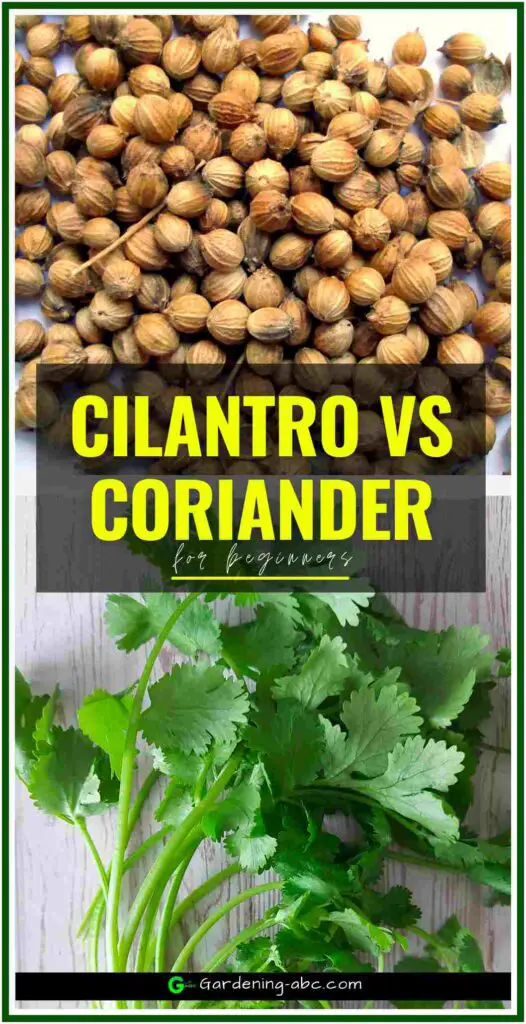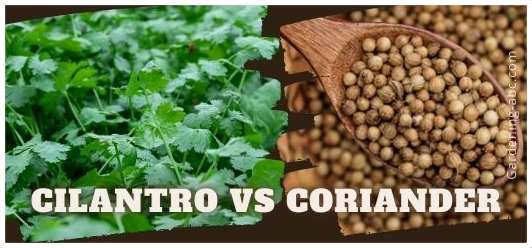We use affiliate links to run our site. When you buy through links on our site, we may earn an affiliate commission, without any added cost to you. Learn more
Cilantro, and coriander, are two of the most commonly confused herbs. And it’s easy to see why. They have many similarities. But they also have one big difference that matters in a culinary sense.
In this post we will discuss is the two are the same plant or is there any difference between the two.
Read on, this will be very interesting.
in a nutshell:
Cilantro and coriander come from the same plant but they taste different and have different uses. Cilantro is the leaves and stems of the plant. When the same plant flowers and turns seed the seeds are called coriander seeds.
But there is more to it and if there are ever confusing herbs, it’s cilantro and coriander.
Let’s dig in deeper into the subject.
What Is Cilantro?
Cilantro (Coriandrum sativum) is an herb in the Apiaceae family of plants. Cilantro is most popular for its delicate, bright green leaves.
Cilantro is sometimes called coriander, Chinese parsley, and Mexican parsley in other parts of the world.
What Is Coriander?
In the US the dried seeds of the cilantro are called coriander.
Coriander seeds are like tiny tan-hued beads with ridges. You can use them whole or crushed or ground.
Internationally, Coriander is the name for the leaves and stalks of the plant, while the dried seeds are called coriander seeds.
Is Cilantro Coriander?
The answer to this question depends on whom you ask. To some people, cilantro refers only to fresh leaves from the coriander plant (Coriandrum sativum).
To others, it also includes dried seeds from the same plant that have been ground into a spice powder (also known as coriander).
Confusing matters further are several varieties of cilantro that may look different from each other but share the same name — such as Mexican vs. Indian vs. Chinese cilantro.
What Do Coriander and Cilantro Mean in Different Countries?
While in the US the word coriander means only the dried seeds of the herb, in the UK and other European countries the term means both the seeds as well as the leaves and the stems.
In India, the herb is referred to as “dhania” to distinguish the leaves from the coriander seeds.
Nutrients:
Cilantro leaves have high levels of vitamin A, C, and K. The Leaves also have trace amounts of minerals such as Iron, Magnesium, Calcium, Copper, Potassium, Zinc, etc.
Coriander seeds also have those same minerals but in much larger quantities. VItamins on the other hand are quite low in coriander seeds. The seeds also have a lot of dietary fiber compared to the leaves.
The water content of the cilantro leaves is quite high about 92% compared to only 9% in the seeds.
The Taste:
CIlantro and coriander seeds are quite different in taste and flavor.
Cilantro has a distinctive taste that’s often described as fresh or herbal, with hints of citrus and pine needles.
Cilantro has a strong flavor that people either love or hate — it’s one of those polarizing herbs that divides people into camps of loyalists and haters alike. Many people enjoy its refreshing taste and aroma, but others can’t stand it.
The leaves are usually chopped and added to salads, soups, stews, meat dishes, and sauces.
Coriander seeds appear to have a softer taste and smell. It has a warm, spicy, and nutty aroma that has a hint of citrus in it.
You can intensify the flavor of coriander seeds by toasting the seeds. Place the seeds in a dry skillet and heat over medium heat until they become fragrant (usually within a minute).
After that, crush them using a mallet or the bottom of a heavy skillet.
In culinary practices, coriander seeds are most commonly used with cumin and cinnamon.
Can You Substitute Coriander for Cilantro?
As you can see the leaves and the seeds are quite different in their taste, and smell as well as in their nutrient contents. So substituting one with the other is not possible every time.
in addition, as the term “coriander” can refer to both seeds and the leaves (in other parts of the world) it can get really confusing while following a recipe.
So whenever you choose a recipe that has coriander in it, look carefully at the processing, does it means the seeds or the leaves and the stems of the plant.
conclusion:
I hope this post helped you clear your doubts. Now go and get some cilantro for your garden. This post will help you get all the necessary information for growing cilantro plants.
If you like the information, share it with others, and Don’t Forget to PIN IT.

Amazon and the Amazon logo are trademarks of Amazon.com, Inc, or its affiliates.

Hi there! My name is Prasenjit and I’m an avid gardener and someone who has grown a passion for growing plants. From my hands-on experience, I have learned what works and what doesn’t. Here I share everything I have learned.
